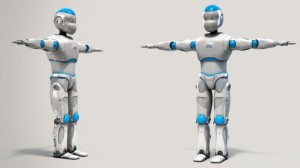Five years have passed since Aldebaran Robotics announced an ambitious joint project with over a dozen leading French research centres to make France one of the few countries to have developed an advanced humanoid robot. Finally, the robot, named Romeo, made its long-awaited debut at the Innorobo robotics fair, which was held earlier last month in Lyon.
Aldebaran Robotics hit the big time with its famed Nao robot, which immediately conquered the love of the robotics community, and it was only a question of time before Aldebaran would face the challenge of creating a larger and more capable robot. Romeo, who stands 1,40 meters tall and weighs around 40 kg, however, is not just an enlarged version of Nao and, although not without some synergy between the two projects, the researches had to develop in many ways a very different humanoid.
Romeo was conceived as a personal assistant to elderly and disabled people and will have to move in an everyday environment and, in theory, perform such tasks as fetching objects, take out the trash and monitor the owner’s health, mood and behaviour.
Safety was a major concern when designing the physical platform, for a bigger robot implies bigger risks, and so Aldebaran set about developing a robot that neither looks dangerous, nor is a danger. In this regard, the project has made some important advances: unlike most humanoids, which rely on gears to power their joints, Romeo’s joints – and most importantly leg joints – are based on a very light and low-friction backdrivable mechanism consisting of screws and cables, which offers more control over the robot and is considerably safer and cheaper. A good example of a backdrivable robot is the WAM arm from Barrett Technology.
Romeo, of course, still remains in the development stage, which was fairly obvious at Innorobo. So far, the robot seems to have limited mobility and cognitive capabilities, and it might be too early to talk about how Romeo stands up to what was promised at the beginning of the project. Some parts of the robot will be almost definitely improved along the way: Romeo’s hands, for instance, now have four fingers each and just one degree of freedom, which allows him to perform only a basic grasping motion – clearly not enough to perform most of the tasks envisioned for the robot.
Aldebaran hopes that Romeo will start working at aged care facilities by the year 2017 or, at the latest, by 2019. And, although it might seem unrealistic – given the rumoured cost of Romeo at around $ 330.000 – Aldebaran has plans for commercialising the robot by offering it to hospitals and nursing homes and eventually to individuals.
For more information on Romeo, you can read this article.






Pingback: Is Pepper the world’s hottest personal robot yet? | Convergent Science Network